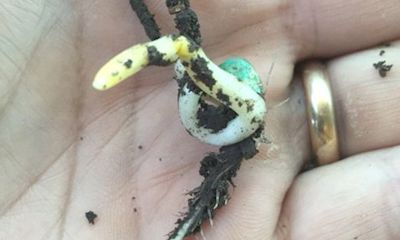May 9, 2016

As of Sunday, May 1, Nebraska farmers had already planted 26% of the state's 2016 corn crop (USDA-NASS). That contrasts with 45% in 2015, but compares well with the five-year average of 31%. As the days pass, anxiety swells for farmers whose corn lies in the shed – not in the ground. Let's think about options for those with – and without – seed in the ground.
For corn that is not yet planted:
1. It's too early to think about either switching hybrids or switching to another crop. There is still considerable time left before those become reasonable options. For more information on switching hybrids see Elmore et al., 2015).

SCOUTING ENCOURAGED: Scouting is encouraged in corn that was planted early in cool soils to determine if there may be stand problems due to poor or variable emergence. Figures 1-3, left to right: Figure 1. Corn subjected to soil temperatures below 50 F immediately after germination may suffer development and emergence problems, such as this corkscrewed seedling. This would not produce a viable plant. Figure 2. Another corn emergence issue is when corn leafs out below the soil surface. Figure 3. Corn leafing out below the soil surface is one indicator of low soil temperatures after germination. (Photo on the left is by Travis Kinnison; others are by Roger Elmore)
2. We all know that on average, as planting dates move into May, corn yields drop. What we need to remember is that 2016 may not be an average year! Indeed we may not yet have reached the best planting date for corn in 2016.
3. Waiting for optimum soil conditions for early-season germination and seedling development is far better than "mudding in" corn.
For the 26% of corn that is planted:
1. Corn seed subjected to soil temperatures at planting depth less than 50°F within 48 hours after planting may be subject to imbibitional chilling which may affect seedling germination. (See Specht et al. 2016.) Corkscrewing of seedlings (Figure 1) also may occur and seedlings may attempt to unroll below the soil surface (Figure 2). This can affect emergence timing and seedling performance.
2. As corn emerges, assess stands carefully.
• With the recent cool soil temperatures, corn will certainly emerge slowly and most likely irregularly. One "secret" of optimum yields is uniform emergence and early season growth and development. However, with reasonable plant populations, keeping stands with irregular emergence is better than replanting in most circumstances.
• If emerged corn encounters a freeze, yields may be reduced and the potential need for replanting needs to be assessed. (See McMechan and Elmore, 2016).
• Consider replanting with severe reductions in plant populations (See Elmore et al. 2015).
For more information, contact Roger Elmore, University of Nebraska cropping systems agronomist at [email protected].
Source: UNL CropWatch
You May Also Like




